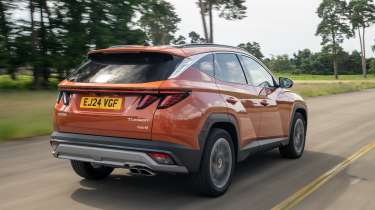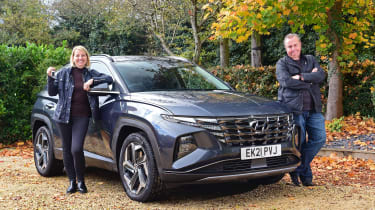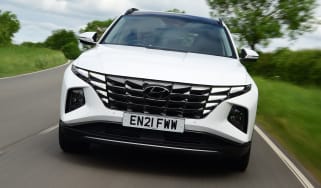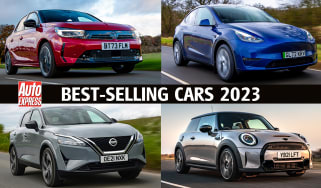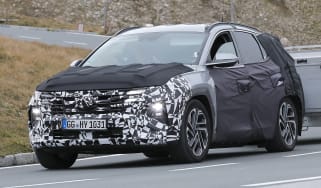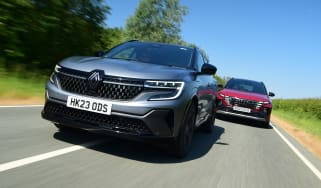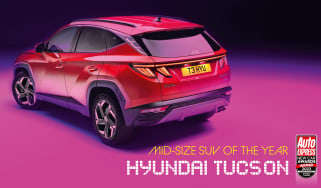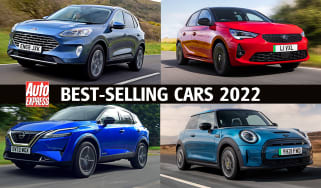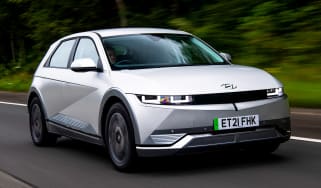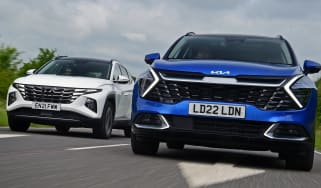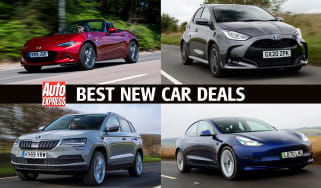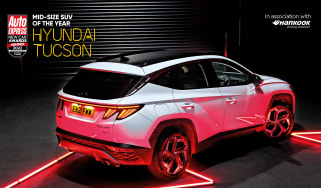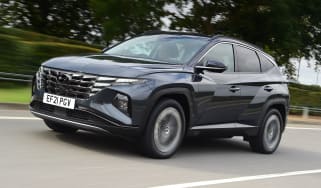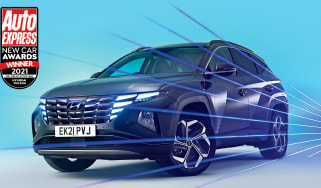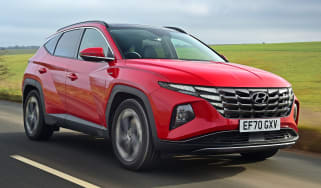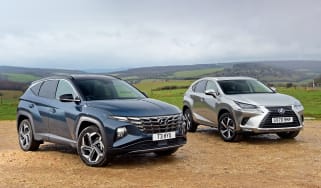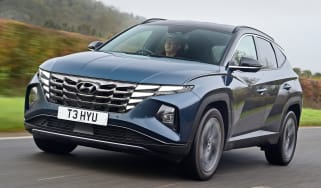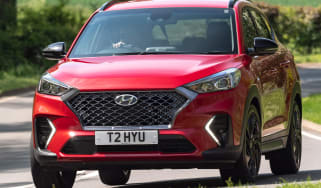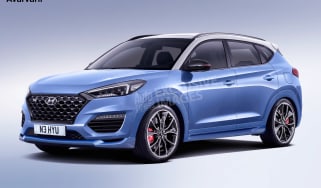Hyundai Tucson review
The Hyundai Tucson combines refinement, space, style and hybrid technology to create a mid-size SUV that’s proving hard to beat

Quick Verdict:
The latest Hyundai Tucson means business. Its striking looks, intuitive on-board tech and premium-feeling cabin help it stand out in the overcrowded mid-size SUV class, but the Tucson is a car that appeals to the head as well as to the heart. Efficiency-boosting hybrid technology and high levels of standard equipment can be found throughout the range, while the interior is one of the roomiest in the class and the boot is large enough to rival those of estate cars.
Yes, you’ll find the Tucson a little more expensive to buy now, but we think Hyundai has managed to create a family car that’s as desirable as it is sensible. That’s why we named it our Mid-size SUV of the Year in 2021, 2022, 2023, and 2024.
|
Key specs | |
|
Fuel type |
Petrol, hybrid, plug-in hybrid |
|
Body style |
Mid-size SUV |
|
Powertrain |
1.6-litre, 4cyl, turbo petrol, front-wheel drive 1.6-litre, 4cyl, turbo petrol plus 1x e-motor, front-wheel drive 1.6-litre, 4cyl, turbo petrol plus 1x e-motor, four-wheel drive 1.6-litre, 4cyl, turbo petrol plus 1x e-motor with 13.8kWh battery, front-wheel drive 1.6-litre, 4cyl, turbo petrol plus 1x e-motor with 13.8kWh battery, four-wheel drive |
|
Safety |
Five-star Euro NCAP (2021) |
Hyundai Tucson: price, specs and rivals
Let’s cut straight to the chase – the previous Tucson was a car that primarily sold itself on practicality, modest pricing and family usability, while decent levels of kit went some way towards making up for its distinct lack of flair.
However, this fourth generation of Hyundai’s mid-size SUV is a different proposition, and keen to establish itself as a premium offering for families that value style and refinement, as well as the more prosaic qualities of overall load space and day-to-day functionality.
Competition is fierce in this sector of the market, and many of the Tucson’s rivals have established USPs that help them stand out from the pack. The Volkswagen Tiguan has an unmistakable air of quality and a solid reputation, while the Ford Kuga is highly rated and brings a sense of driving fun to family SUV life. The Skoda Karoq and SEAT Ateca offer different blends of the tried and trusted Volkswagen Group formula, with Peugeot’s 3008 delivering a classy cabin and typical Gallic charm.
Used - available now

2023 Hyundai
Tucson
29,517 milesManualPetrol1.6L
Cash £19,800
2023 Hyundai
Tucson
23,236 milesManualPetrol1.6L
Cash £16,500
2023 Hyundai
Tucson
55,269 milesAutomaticPetrol1.6L
Cash £19,500
2023 Hyundai
Tucson
47,288 milesManualPetrol1.6L
Cash £16,287Also worth a mention among the myriad choices are the Japanese trio of the Honda CR-V, Mazda CX-5, and Toyota RAV4, followed by yet further options in the form of the evergreen Nissan Qashqai, Renault Austral, Vauxhall Grandland and the Tucson’s own sister car, the Kia Sportage.
We’ve pitted the Tucson against multiple contenders over the years, with the Hyundai walking away with the winner’s medal each time. We have no doubt that Hyundai is clearly focused on not only taking on the best of the mainstream, but also nipping at the heels of the more upmarket brands like Audi and BMW.
With prices starting from around £32,000, the Tucson range undercuts the Kuga and Tiguan. However, Hyundai doesn’t really offer a typical entry-level trim, so you’ll be well catered for in terms of equipment even with the ‘base’ car.
The trim structure is pretty straightforward, starting with Advance before building up to Premium, followed by the sportier-looking N Line and N Line S, before topping out at Ultimate. The standard kit on every model includes dual-zone air-con, cruise control, a rear camera, and a 10.25-inch infotainment touchscreen with sat-nav and Android Auto and Apple CarPlay connectivity.
The N Line models feature sporty tweaks inside and outside, and this trim is Hyundai’s riposte to cars like the VW Tiguan R-Line. You get 19-inch alloys, more aggressive bumpers, twin tailpipes, a tailgate spoiler, and sports front seats. Top-spec cars feature luxuries such as adaptive cruise control, an electric tailgate, a panoramic glass sunroof, heated and ventilated front seats and wireless mobile phone charging.
Power options centre around a 1.6-litre turbocharged petrol engine in various states of tune and with varying degrees of hybrid assistance. You can have a 158bhp petrol-only model with a regular six-speed manual gearbox, or a seven-speed dual-clutch automatic with 48-volt mild-hybrid tech.
A full-hybrid model is also available, using a 1.49kWh battery and a 59bhp electric motor that works with the petrol engine to produce a total output of 212bhp. The engine options are rounded off with a 249bhp plug-in hybrid version with a pure-electric driving range of 38 miles.
Engines, performance & drive
The Hyundai Tucson strikes a good balance between being easy to drive and manoeuvre in town, stable and grippy enough for you to confidently maintain speed on a country road and offering a composed ride on the motorway. The petrol engines can be a bit thrashy when pushed, which is why we’d recommend going for the hybrid, because that can run without the engine in certain situations, improving refinement in the process. Read more about the Hyundai Tucson's engines, performance and drive…
MPG, emissions & running costs
While the petrol Hyundai Tucson isn’t quite as economical as some of its rivals, the hybrid model we recommend has genuine efficiency that translates well into the real world, as we have discovered during our long-term test. Depreciation is respectable compared with the Tucson’s rivals, as well as its insurance rankings. Read more about the Hyundai Tucson's MPG, emissions and running costs…
Interior, design & technology
Big changes have been made to the interior of the Hyundai Tucson, which now has a dashboard design similar to that of its smaller Hyundai Kona and all-electric Hyundai Ioniq 5 siblings. The interior upgrade brings with it some infotainment improvements that make it easier to find the driver assistance menu, plus physical dials for the climate control. Read more about the Hyundai Tucson's interior, design and technology…
Boot space, comfort & practicality
You won’t be wanting for boot capacity with the Hyundai Tucson, which has much more cargo carrying capacity than a Nissan Qashqai, or (if you happen to go for a hybrid or plug-in hybrid Tucson) a eHybrid Volkswagen Tiguan. The Tucson also has a versatile 40/20/40 split folding rear seat design, plus there’s plenty or room whether you’re sat in the front or the back. Read more about the Hyundai Tucson's boot space, comfort and practicality…
Reliability & safety
The Hyundai Tucson scored a maximum five-star rating when it was crash tested in 2021. The Tucson comes with plenty of standard safety assistance technology, although you’ll need to go for an N Line S or Ultimate trim to get blind spot monitoring and rear cross traffic alert. The Hyundai brand offers a longer warranty than many of its rivals, and the manufacturer does reasonably well in our Driver Power customer satisfaction survey. Read more about the Hyundai Tucson’s reliability and safety…
Should you buy a Hyundai Tucson?
If ever there was a mid-size SUV that you should put at the top of your shopping list, the Hyundai Tucson is it. We’ve voted it best in class for the last four years, and the facelifted version only improves what was already a winning formula.
The Tucson is the sort of car that will appeal to those looking for good value thanks to its strong equipment list and keen pricing, while its range of petrol and hybrid engines mean it’ll suit those with an eye on running costs, too. It also has a versatile interior with all the space a growing family would need, plus it has the level of refinement expected of a car that’ll be required to tackle the odd long trip in the summer holidays.
Sure, it isn’t as fun to drive as a Ford Kuga, but the Tucson will be more than good enough for most buyers, with safe and secure handling. The plug-in hybrid powertrain doesn’t have the electric range of the Volkswagen Tiguan’s, which may deter some company car drivers, but at least the Tucson doesn’t cost quite as much as that car in the first place.
Hyundai Tucson Ultimate hybrid: long-term test
In 2021, our former editor Steve Fowler and his family ran a top-of-the-range Ultimate trim Hyundai Tucson for 8,000 miles. They (including their goldendoodle) were all won over by its extensive equipment list, lots of interior space, and - of course - its styling.
The family took the Tucson far and wide across the country on their summer holiday, managing mid-40s fuel economy and making full use of its Highway Driving Assist system.
Frequently Asked Questions
The Hyundai Tucson is a stylish, refined and incredibly practical car, not to mention the winner of our Mid-size SUV of the Year award for the past four years.


